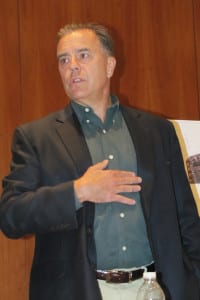By Ali Gordon
This is my fourth year serving as a trustee of the Comsewogue Board of Education. I love every minute of it, because I love my community and I take very seriously the responsibility entrusted to me. The thoughts expressed here are my own. I do not speak for the Comsewogue School District or the Board of Education. We have been warned that a trustee who speaks out could be removed by the state education commissioner. But our schools and our children depend on those of us who were elected to represent the best interests of our community. I cannot stay quiet for fear of retribution from the New York State Education Department anymore.
There has been tremendous criticism of Gov. Andrew Cuomo’s recent decision to withhold state aid and extort legislators into passing his education reforms. Our state legislators are stuck between agreeing to terrible reforms or refusing, leading to a late state budget and a potential loss of millions of dollars for schools.
Cuomo’s proposals include measures such as increasing the time to earn tenure from three to five years and evaluating teachers more heavily based upon their students’ state test scores.
The reforms Cuomo is pushing are disingenuous and dangerous; he works out of the privatization handbook and uses inflammatory statistics. He cannot think of another way to move forward in education except through obsessive testing. Cuomo and the Board of Regents use a one-size-fits-all answer that will never work for every community, while an entire generation of students is being sacrificed for testing data.
Each of Cuomo’s education policies reflect a desire to remove local control. He insists that NYSED investigate the teacher evaluations procedures of Long Island school districts, thinking the system is skewed. Those local evaluation plans were approved by the very same entity, NYSED. Here is what Cuomo cannot fathom: Teachers on Long Island were rated highly effective or effective because they are. If Long Island was a state, we would rank near the top in high school graduation rates, Intel Science Talent Search semifinalists and Siemens Competition semifinalists. Cuomo prefers to ignore these statistics because they do not fit his narrative.
There are several ways to stop the destruction of public schools:
Cuomo must separate his education reforms from his executive budget proposal. If he believes in these reforms, he should let them stand alone as legislation, allow a healthy debate and not circumvent the separation of powers established by our Constitution.
The Legislature should ensure that new Board of Regents appointees have public education experience — they establish state education policies, and interviews are now being held for four appointees.
Parents must educate themselves and make a decision regarding testing in grades three through eight. This will be the third year my children have refused to take the state exams. This is the strongest weapon we have in the fight to save public education. As the number of test refusals grows, the reforms dependent upon those numbers will falter. We will starve the testing machine.
It is time to work together to elevate public education without destroying things that are already working. I cannot sit by quietly anymore and wait for someone else to stand up. I have a sworn duty to represent the interests of my community, including speaking out against policies that endanger the well-being of our students and faculty.
















